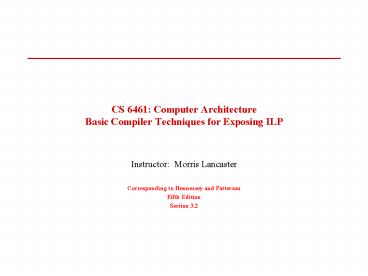CS 6461: Computer Architecture Basic Compiler Techniques for Exposing ILP - PowerPoint PPT Presentation
Title:
CS 6461: Computer Architecture Basic Compiler Techniques for Exposing ILP
Description:
... (r1) add.d f8,f6,f2 s.d f8,-8(r1) l.d f10,-16(r1) add.d f12,f10,f2 s.d f12,-16(r1) l.d f14,-24(r1) add.d f16,f14,f2 s.d f16,-24(r1) daddui ... – PowerPoint PPT presentation
Number of Views:34
Avg rating:3.0/5.0
Title: CS 6461: Computer Architecture Basic Compiler Techniques for Exposing ILP
1
CS 6461 Computer ArchitectureBasic Compiler
Techniques for Exposing ILP
- Instructor Morris Lancaster
- Corresponding to Hennessey and Patterson
- Fifth Edition
- Section 3.2
2
Basic Compiler Techniques for Exposing ILP
- Crucial for processors that use static issue, and
important for processors that make dynamic issue
decisions but use static scheduling
3
Basic Pipeline Scheduling and Loop Unrolling
- Exploiting parallelism among instructions
- Finding sequences of unrelated instructions that
can be overlapped in the pipeline - Separation of a dependent instruction from a
source instruction by a distance in clock cycles
equal to the pipeline latency of the source
instruction. (Avoid the stall) - The compiler works with a knowledge of the amount
of available ILP in the program and the
latencies of the functional units within the
pipeline - This couples the compiler, sometimes to the
specific chip version, or at least requires the
setting of appropriate compiler flags
4
Assumed Latencies
Instruction Producing Result Instruction Using Result Latency In Clock Cycles (needed to avoid stall)
FP ALU op Another FP ALU op 3
FP ALU op Store double 2
Load double FP ALU op 1
Load double Store double 0 Result of the load can be bypassed without stalling store
5
Basic Pipeline Scheduling and Loop Unrolling
(cont)
- Assume standard 5 stage integer pipeline
- Branches have a delay of one clock cycle
- Functional units are fully pipelined or
replicated (as many times as the pipeline depth) - An operation of any type can be issued on every
clock cycle and there are no structural hazards
6
Basic Pipeline Scheduling and Loop Unrolling
(cont)
- Sample code
- For (i1000 igt0 ii-1)xi xi s
- MIPS code
- Loop L.D F0,0(R1) F0 array
element ADD.D F4,F0,F2 add scalar in
F2 S.D F4,0(R1) store back - DADDUI R1,R1,-8 decrement index
- BNE R1,R2,Loop R2 is precomputed so
that 8(R2) is last value to
be computed
7
Basic Pipeline Scheduling and Loop Unrolling
(cont)
- MIPS code
- Loop L.D F0,0(R1) 1 clock cycle
- stall 2 ADD.D F4,F0,F2 3 stall 4
stall 5 S.D F4,0(R1) 6 - DADDUI R1,R1,-8 7 stall 8
- BNE R1,R2,Loop 9
8
Rescheduling Gives
- Sample code
- For (i1000 igt0 ii-1)xi xi s
- MIPS code
- Loop L.D F0,0(R1) 1 DADDUI R1,R1,-8 2
ADD.D F4,F0,F2 3 stall 4 stall 5 - S.D F4,8(R1) 6
- BNE R1,R2,Loop 7
9
Unrolling Summary (continued)
- Simple Unroll Loop L.D F0,0(R1) ADD.D F4,F
0,F2 S.D F4,0(R1) L.D F0,-8(R1) ADD.D F4,F0
,F2 S.D F4,-8(R1) L.D F0,-16(R1) ADD.D F4,F0
,F2 S.D F4,-16(R1) L.D F0,-24(R1) ADD.D F4,F
0,F2 S.D F4,-24(R1) - DADDUI R1,R1,-32 BNE R1,R2,Loop
Name Dependences
Data Dependences
10
Unrolling and Renaming Gives
- MIPS code
- Loop L.D F0,0(R1) ADD.D F4,F0,F2 we have a
stall coming S.D F4,0(R1) L.D F6,-8(R1) ADD
.D F8,F6,F2 S.D F8,-8(R1) L.D F10,-16(R1) AD
D.D F12,F10,F2 - S.D F12,-16(R1) L.D F14,-24(R1) ADD.D F16,F
14,F2 S.D F16,-24(R1) DADDUI R1,R1,-32 BNE
R1,R2,Loop
11
Unrolling and Removing Hazards Gives
- MIPS code
- Loop L.D F0,0(R1) total of 14 clock cycles
L.D F6,-8(R1) - L.D F10,-16(R1) L.D F14,-24(R1) ADD.D F4
,F0,F2 - ADD.D F8,F6,F2 ADD.D F12,F10,F2 ADD.D F16,F
14,F2 S.D F4,0(R1) S.D F8,-8(R1) DADDUI R1,R
1,-32 S.D F12,16(R1) S.D F16,8(R1) BNE
R1,R2,Loop
12
Unrolling Summary for Above
- Determine that it was legal to move the S.D after
the DADDUI and BNE, and find the amount to adjust
the S.D offset - Determine that unrolling the loop would be useful
by finding that the loop iterations were
independent, except for loop maintenance code - Use different registers to avoid unnecessary
constraints that would be forced by using the
same registers - Eliminate the extra test and branch instruction
and adjust the loop termination and iteration
code. - Determine that the loads and stores can be
interchanged by determining that the loads and
stores from different iterations are independent - Schedule the code, preserving any dependencies
13
Unrolling Summary (continued)
- Example on Page 311 shows the steps
Loop L.D F0,0(R1) ADD.D F4,F0,F2 S.D F4,
0(R1) L.D F0,-8(R1) ADD.D F4,F0,F2 S.D F4,-8
(R1) L.D F0,-16(R1) ADD.D F4,F0,F2 S.D F4,-1
6(R1) L.D F0,-24(R1) ADD.D F4,F0,F2 S.D F4,-
24(R1) - DADDUI R1,R1,-32 BNE R1,R2,Loop
Name Dependences
Data Dependences
14
Unrolling Summary (Renaming)
- Example on Page 311 shows the steps
Loop L.D F0,0(R1) ADD.D F4,F0,F2 S.D F4,
0(R1) L.D F6,-8(R1) ADD.D F8,F6,F2 S.D F8,-8
(R1) L.D F10,-16(R1) ADD.D F12,F10,F2 S.D F1
2,-16(R1) L.D F14,-24(R1) ADD.D F16,F14,F2 S
.D F16,-24(R1) - DADDUI R1,R1,-32 BNE R1,R2,Loop
Name Dependences
Data Dependences
15
Unrolling Summary (continued)
- Limits to Impacts of Unrolling Loops
- As we unroll more, each unroll yields a decreased
amount of improvement of distribution of overhead - Growth in code size
- Shortfall in available registers (register
pressure) - Scheduling the code to increase ILP causes the
number of live values to increase - This could generate a shortage of registers and
negatively impact the optimization - Useful in a variety of processors today













![CS184c: Computer Architecture [Parallel and Multithreaded] PowerPoint PPT Presentation](https://s3.amazonaws.com/images.powershow.com/P1252428400vVmSN.th0.jpg?_=20120209038)
















